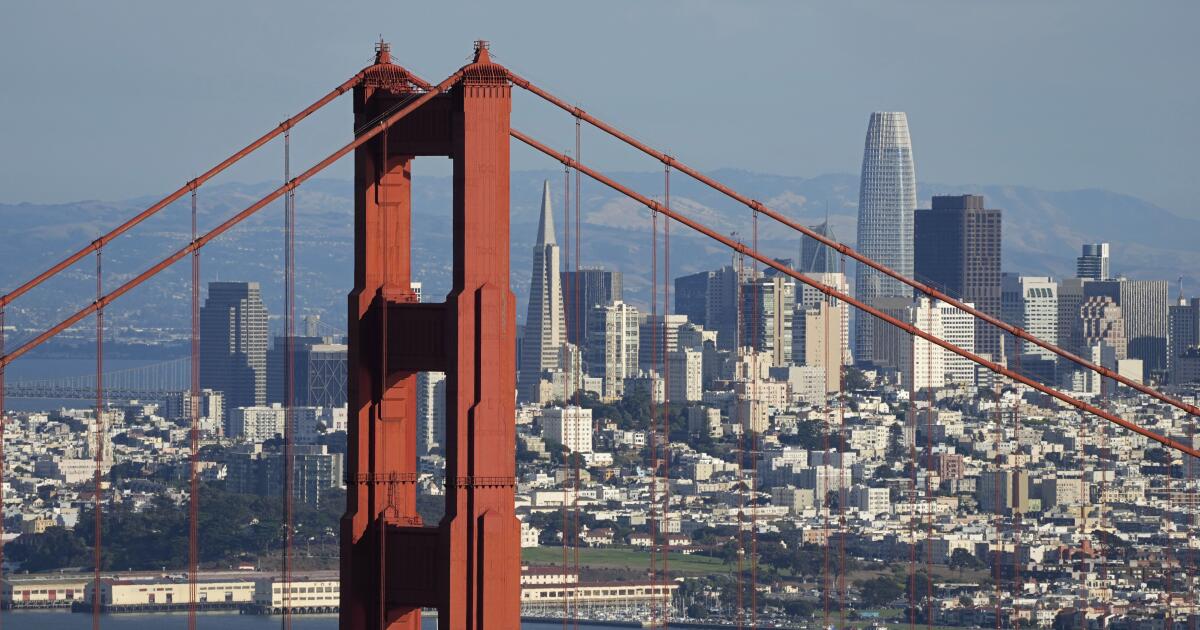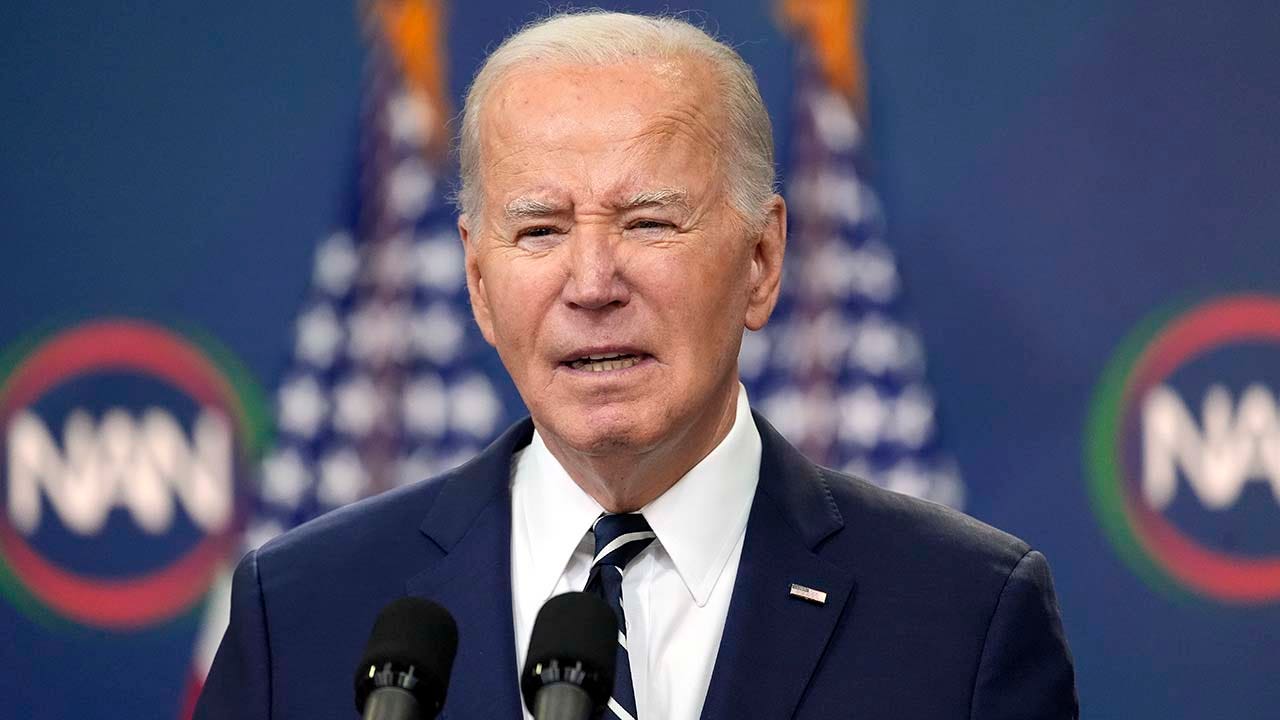Business
Wearing a computer on your face? Snap looks to take on rivals with new augmented reality glasses

For years, Snap has envisioned a future where people wear glasses to view and interact with computer-generated images without having to scroll through their smartphones.
The Santa Monica-based tech company will soon see if its multibillion-dollar bet on augmented reality glasses has paid off.
Snap said Tuesday it plans to release in 2026 AR glasses that people will be able to buy.
Last year, Snap launched the latest version of its AR glasses, but the gadget was only available to developers. The new AR glasses, known as Specs, will be lighter and more advanced than what was shown in 2024, Snap said.
The company behind the disappearing messaging app Snapchat hasn’t revealed the price of the glasses or exactly when they will go on sale.
Augmented reality involves overlaying digital objects onto a person’s view of the physical world, allowing people to wear virtual dog ears on their faces and catch virtual Pokémon. Snap says its glasses will be useful in more ways, helping people translate signs, learn how to play the drums, browse recipes and access AI assistance.
“We’re obsessed with making computers more human. And with advances in AI, computers are thinking and acting like humans more than ever before. But if we want to unleash the true potential of AI, we need to bring it from screens into the real world,” said Evan Spiegel, Snap’s co-founder and chief executive, in his prepared remarks for the Augmented World Expo. The conference, held in Long Beach, focuses on technology such as AR.
Snap is betting big that AR glasses will reshape how people interact with technology, spending more than $3 billion and 11 years building AR glasses. The competition has been fierce.
Snap’s announcement comes as major tech companies including Meta, Google and Apple also work on glasses with AI-powered tools.
Ben Bajarin, chief executive and principal analyst at Creative Strategies, a market research firm in San Jose, said it’s hard for Snap to compete with major tech companies like Google, Meta and OpenAI that have a lot of valuable data that power their AI tools.
“It’s not just the ability to do AR and display. It’s also this multimodal AI engine that ties to cameras and you can interact with it, ” he said.
Even if Snap’s rivals release glasses that don’t display virtual images on top of the physical world, consumers will likely be hesitant to spend more money on extra features.
“If they get the price point down and they become more fun, more whimsical, then they compete on a different vector than what Google and OpenAI and probably Meta are going to try to do,” he said.
While tech companies have released glasses in the past, convincing people to buy them has been an uphill battle. Early versions of Snap’s Spectacles, used for recording videos, and smartglasses such as Google Glass flopped but technology has improved.
President Trump’s on-again, off-again tariffs on goods from countries such as China could also impact the development of new gadgets or consumer appetite to buy new electronics.
Still, tech companies have signaled they’re not ready to give up on building glasses. Meta and Ray-Ban sell smartglasses that let people capture photos and videos, listen to music and interact with an AI assistant. The social media giant also unveiled more capable AR glasses, known as Orion, but they aren’t available for the public to buy.
This year, Google showcased a prototype of its glasses at its developer conference. Paired with a smartphone, people donning the glasses can find more information about a painting or travel by asking its AI assistant, Gemini, a question out loud.
OpenAI, the maker behind ChatGPT, teamed up with Jony Ive — a former Apple executive who helped design the iPhone — to work on a new AI-powered device, but hasn’t revealed what it is.
AR glasses also give Snap another way to make money outside of digital ad sales. In April, Snap’s stock fell more than 15% after the company held back its forecast for the second quarter, sparking concerns that economic uncertainty around Trump’s tariffs could prompt advertisers to pull back spending. As of Tuesday, Snap’s stock has been down more than 24% so far this year at $8.49 per share.
The company has grown its revenue while reducing its net losses. Snap’s first quarter revenue grew 14% from $1.19 billion in 2024 to $1.36 billion this year. The company’s net loss dropped 54% to $140 million.
Snap has more than 900 million monthly active users and 460 million daily active users.

Business
These California metro areas are among the most AI-ready in the nation

Despite suggestions it has been losing its edge, California is way ahead of others when it comes to the hottest technology right now: artificial intelligence.
The regions around San Francisco, San José and Los Angeles are among the best prepped for AI in the country, according to a report released Wednesday by the Brookings Institution.
The Washington think tank dubbed the San Francisco and San José metropolitan areas “superstars” when it comes to AI readiness. Three out of the top 10 city regions most ready for AI are in California, according to the report. No other state has more than one region in the top 10. Texas had none in Brookings’ top 10. Austin was ranked 11th.
With tech giants such as Google, Meta and Nvidia headquartered in the area and OpenAI securing a record-breaking $40 billion in funding this year, it’s no surprise that the Bay Area cities dominate.
“They really are in a class of their own, given the sheer scale, dominant big tech headquarters, massive research labs and venture capital,” said Mark Muro, a senior fellow at the metropolitan policy program at Brookings, who co-wrote the study.
Los Angeles, home to top-tier universities, film studios, defense tech startups, social networks and dating apps, is also a big AI contender. The Los Angeles metro area, which includes Long Beach and Anaheim, is part of the second-highest cluster of AI-ready regions Brookings calls “star hubs,” the report said.
The analysis shows how California metropolitan areas are among the most prepared for AI, technology with the potential to reshape industries as diverse as healthcare and entertainment. The San Diego metro area was also part of a cluster deemed more ready for AI. It was ranked 12th.
Brookings examined venture capital funding, AI job postings, the number of computer science degree holders, patents and other data. The information gathered about 387 metro areas provided insight about whether certain places have more or less AI talent, innovation and adoption.
After analyzing this data, the think tank clustered metro areas into six different groups, indicating which are the most AI-ready. The groups are superstars, star hubs, emerging centers, focused movers, nascent adopters and others. Two metro areas are considered superstars while 28 are star hubs.
The less AI-ready groups lagged behind when it came to major tech employers, computer science graduates, patents, contracts and other factors. Metro areas that included Stockton, Modesto, Visalia and Bakersfield in California were part of the “others” cluster.
Rural counties and small metro areas fell behind when it came to AI talent and innovation, the report said. The number of AI startups and venture capital funding were “virtually nonexistent” in these areas.
AI has the potential to create new jobs, but it could also displace mundane and tedious tasks, reshaping the job market. Making sure that AI doesn’t just put tech workers and other people out of work is one downside more AI-ready metro areas will have to watch out for, Muro said.
Mass layoffs in the tech industry, the release of AI tools that can code and do other tasks, and executive remarks have heightened concerns that companies will shrink their workforce.
Metropolitan areas that included New York, Boston, Washington, Chicago, Atlanta and Seattle were also deemed more AI-ready than other places. Several Texas metropolitan areas that encompass Austin, Dallas, Houston or San Antonio are part of the “star hubs” cluster.
The region around New York was ranked No. 1 for AI readiness for the sheer volume of talent, AI job postings and high-performance computing usage. But researchers also considered other factors such as a region’s density when coming up with clusters and wanted to highlight the Bay Area’s advantage.
The tech industry is growing in Texas, where Austin bears the nickname “Silicon Hills.” Some of the world’s largest tech companies, including Google, Meta and Amazon, have offices in Austin. And some entrepreneurs, including Elon Musk, have moved the headquarters of their companies to Texas in recent years.
The Austin area has a large pool of computer science, engineering and math graduates, but the San Francisco Bay Area still has more AI startups, venture capital deals, patents and U.S. worker profiles with AI skills, data from Brookings show.
The AI economy is massively concentrated on the West Coast, but cities throughout the United States are catching up. The Bay Area, Muro said, will probably remain a central AI hub in the future.
“They will likely not displace the importance of the Bay Area, but they will complement it,” he said.
Business
Commentary: Stephen Miller says Americans will live better lives without immigrants. He's blowing smoke

Stephen Miller, the front man for Donald Trump’s deportation campaign against immigrants, took to the airwaves the other day to explain why native-born Americans will just love living in a world cleansed of undocumented workers.
“What would Los Angeles look like without illegal aliens?” he asked on Fox News. “Here’s what it would look like: You would be able to see a doctor in the emergency room right away, no wait time, no problems. Your kids would go to a public school that had more money than they know what to do with. Classrooms would be half the size. Students who have special needs would get all the attention that they needed. … There would be no fentanyl, there would be no drug deaths.” Etc., etc.
No one can dispute that the world Miller described on Fox would be a paradise on Earth. No waiting at the ER? School districts flush with cash? No drug deaths? But that doesn’t obscure that pretty much every word Miller uttered was fiction.
The leaders in Los Angeles have formed an alliance with the cartels and criminal aliens.
— Trump aide Stephen Miller concocts a fantasy about L.A.
The gist of Miller’s spiel — in fact, the worldview that he has been espousing for years — is that “illegal aliens” are responsible for all those ills, and exclusively responsible. It’s nothing but a Trumpian fantasy.
Let’s take a look, starting with overcrowding at the ER.
The issue has been the focus of numerous studies and surveys. Overwhelmingly, they conclude that undocumented immigration is irrelevant to ER overcrowding. In fact, immigrants generally and undocumented immigrants in particular are less likely to get their healthcare at the emergency room than native-born Americans.
In California, according to a 2014 study from UCLA, “one in five U.S.-born adults visits the ER annually, compared with roughly one in 10 undocumented adults — approximately half the rate of U.S.-born residents.”
Among the reasons, explained Nadereh Pourat, the study’s lead author and director of research at the UCLA Center for Health Policy Research, was fear of being asked to provide documents.
The result is that undocumented individuals avoid seeking any healthcare until they become critically ill. The UCLA study found that undocumented immigrants’ average number of doctor visits per year was lower than for other cohorts: 2.3 for children and 1.7 for adults, compared with 2.8 doctor visits for U.S.-born children and 3.2 for adults.
ER overcrowding is an issue of long standing in the U.S., but it’s not the result of an influx of undocumented immigrants. It’s due to a confluence of other factors, including the tendency of even insured patients to use the ER as a primary care center, presenting with complicated or chronic ailments for which ER medicine is not well-suited.
While caseloads at emergency departments have surged, their capacities are shrinking.
According to a 2007 report by the National Academy of Sciences, from 1993 to 2003 the U.S. population grew by 12%, hospital admissions by 13% and ER visits by 26%. “Not only is [emergency department] volume increasing, but patients coming to the ED are older and sicker and require more complex and time-consuming workups and treatments,” the report observed. “During this same period, the United States experienced a net loss of 703 hospitals, 198,000 hospital beds, and 425 hospital EDs, mainly in response to cost-cutting measures.”
President Trump’s immigration policies during his first term suppressed the use of public healthcare facilities by undocumented immigrants and their families. The key policy was the administration’s tightening of the “public charge” rule, which applies to those seeking admission to the United States or hoping to upgrade their immigration status.
The rule, which has been part of U.S. immigration policy for more than a century, allowed immigration authorities to deny entry — or deny citizenship applications of green card holders — to anyone judged to become a recipient of public assistance such as welfare (today known chiefly as Temporary Assistance for Needy Families, or TANF) or other cash assistance programs.
Until Trump, healthcare programs such as Medicaid, nutrition programs such as food stamps, and subsidized housing programs weren’t part of the public charge test.
Even before Trump implemented the change but after a draft version leaked out, clinics serving immigrant communities across California and nationwide detected a marked drop off in patients.
A clinic on the edge of Boyle Heights in Los Angeles that had been serving 12,000 patients, I reported in 2018, saw monthly patient enrollments fall by about one-third after Trump’s 2016 election, and an additional 25% after the leak. President Biden rescinded the Trump rule within weeks of taking office.
Undocumented immigrants are sure to be less likely to access public healthcare services, such as those available at emergency rooms, as a result of Trump’s rescinding “sensitive location” restrictions on immigration agents that had been in effect at least since 2011.
That policy barred almost all immigration enforcement actions at schools, places of worship, funerals and weddings, public marches or rallies, and hospitals. Trump rescinded the policy on inauguration day in January.
The goal was for Immigration and Customs Enforcement, or ICE, agents “to make substantial efforts to avoid unnecessarily alarming local communities,” agency officials stated. Today, as public shows of force and public raids by ICE have demonstrated, instilling alarm in local communities appears to be the goal.
The change in the sensitive locations policy has prompted hospital and ER managers to establish formal procedures for staff confronted with the arrival of immigration agents.
A model policy drafted by the Emergency Medicine Residents Assn. says staff should request identification and a warrant or other document attesting to the need for the presence of agents. It urges staff to determine whether the agents are enforcing a judicial warrant (signed by a judge) or administrative warrant (issued by ICE). The latter doesn’t grant agents access to private hospital areas such as patient rooms or operating areas.
What about school funding? Is Miller right to assert that mass deportations will free up a torrent of funding and cutting class sizes in half? He doesn’t know what he’s talking about.
Most school funding in California and most other places is based on attendance. In California, the number of immigrant children in the schools was 189,634 last year. The total K-12 population was 5,837,700, making the immigrant student body 3.25% of the total. Not half.
In the Los Angeles Unified School District, the estimated 30,000 children from immigrant families amounted to about 7.35% of last year’s enrollment of 408,083. Also not half.
With the deportation of immigrant children, the schools would lose whatever federal funding was attached to their attendance. Schools nationwide receive enhanced federal funding for English learners and other immigrants. That money, presumably, would disappear if the pupils go.
What Miller failed to mention on Fox is the possible impact of the Trump administration’s determination to shutter the Department of Education, placing billions of dollars of federal funding at risk. California receives more than $16 billion a year in federal aid to K-12 schools through that agency. Disabled students are at heightened risk of being deprived of resources if the agency is dismantled.
Then there’s fentanyl. The Trump administration’s claim that undocumented immigrants are major players in this crisis appears to be just another example of its scapegoating of immigrants. The vast majority of fentanyl-related criminal convictions — nearly 90% — are of U.S. citizens. The rest included both legally present and undocumented immigrants. (The statistics comes from the U.S. Sentencing Commission.)
In other words, deport every immigrant in the United States, and you still won’t have made a dent in fentanyl trafficking, much less eliminate all drug deaths.
What are we to make of Miller’s spiel about L.A.? At one level, it’s echt Miller: The portrayal of the city as a putative hellscape, larded with accusations of complicity between the city leadership and illegal immigrants — “the leaders in Los Angeles have formed an alliance with the cartels and criminal aliens,” he said, with zero pushback from his Fox News interlocutor.
At another level, it’s a malevolent expression of white privilege. In Miller’s ideology, the only obstacles to the return to a drug-free world of frictionless healthcare and abundantly financed education are immigrants. This ideology depends on the notion that immigrants are raiding the public purse by sponging on public services.
The fact is that most undocumented immigrants aren’t eligible for most such services. They can’t enroll in Medicare, receive premium subsidies under the Affordable Care Act, or collect Social Security or Medicare benefits (though typically they submit falsified Social Security numbers to employers, so payments for the program are deducted from their paychecks).
A 2013 study by the libertarian Cato Institute found that low-income immigrants use public benefits for which they’re eligible, such as food stamps, “at a lower rate than native-born low-income residents.”
If there’s an impulse underlying the anti-immigrant project directed by Miller other than racism, it’s hard to detect.
Federal Judge Maame Ewusi-Mensah Frimpong, who last week blocked federal agents from using racial profiling to carry out indiscriminate immigration arrests in Los Angeles, ruled that during their “roving patrols” in Los Angeles, ICE agents detained individuals principally because of their race, that they were overheard speaking Spanish or accented English, that they were doing work associated with undocumented immigrants, or were in locations frequented by undocumented immigrants seeking day work.
Miller goes down the same road as ICE — indeed, by all accounts, he’s the motivating spirit behind the L.A. raids. Because he can’t justify the raids, he has ginned up a fantasy of immigrants disrupting our healthcare and school programs, and the corollary fantasy that evicting them all will produce an Earthly paradise for the rest of us. Does anybody really believe that?
Business
Musk says he will seek shareholder approval for Tesla investment in xAI

Tech billionaire Elon Musk said he would like Tesla to invest in his artificial intelligence company xAI.
While Musk is considering the relationship between several of his businesses, he said on X that he does not support a merger between Tesla and xAI.
“If it was up to me, Tesla would have invested in xAI long ago,” Musk wrote on X on Sunday. “We will have a shareholder vote on the matter.”
xAI is the company behind the controversial chatbot Grok, which is available on X and also used in Teslas delivered on or after July 12. Grok came under fire earlier this month for praising Adolf Hitler and making antisemitic comments.
The AI company apologized for the chatbot’s behavior, saying that a coding problem temporarily made Grok susceptible to extremist views posted on X.
Earlier, Grok had contradicted itself while sharing information about the deadly flash floods that killed at least 130 people in Texas this month. The bot blamed President Trump for the flooding, but then backtracked and understated the death toll.
Musk is scrambling to keep up in the AI race after helping launch OpenAI with Sam Altman in 2015, the company behind the wildly popular chatbot ChatGPT, which helped spur on the current AI craze. Musk left OpenAI in 2018 and is now entangled in legal battles with the company.
In March, xAI acquired X in an all-stock transaction that valued the artificial intelligence company at $80 billion and the social media platform at $33 billion.
Musk scored a victory for Grok on Monday, when xAI announced “Grok for Government” and a contract with the U.S. Department of Defense.
After a disruptive stint in the Trump administration that sent Tesla shares stumbling, Musk formally stepped down from his role in the federal government in May. He has since been feuding with the president, further risking Tesla’s reputation, according to some experts.
Tesla shares rose slightly Monday after Musk’s posts about Tesla’s possible investment in xAI. The shares have fallen more than 16% this year. The company’s profit plunged 71% in the first quarter.
Tesla delivered 384,122 vehicles in the second quarter through June, down 13% from 443,956 deliveries a year ago.
Its shares rose more than 1% Monday.
-

 Culture1 week ago
Culture1 week agoTry to Match These Snarky Quotations to Their Novels and Stories
-

 News6 days ago
News6 days agoVideo: Trump Compliments President of Liberia on His ‘Beautiful English’
-

 News1 week ago
News1 week agoTexas Flooding Map: See How the Floodwaters Rose Along the Guadalupe River
-
Business1 week ago
Companies keep slashing jobs. How worried should workers be about AI replacing them?
-
Finance1 week ago
Do you really save money on Prime Day?
-

 Technology1 week ago
Technology1 week agoApple’s latest AirPods are already on sale for $99 before Prime Day
-

 News5 days ago
News5 days agoVideo: Clashes After Immigration Raid at California Cannabis Farm
-

 Politics1 week ago
Politics1 week agoJournalist who refused to duck during Trump assassination attempt reflects on Butler rally in new book















